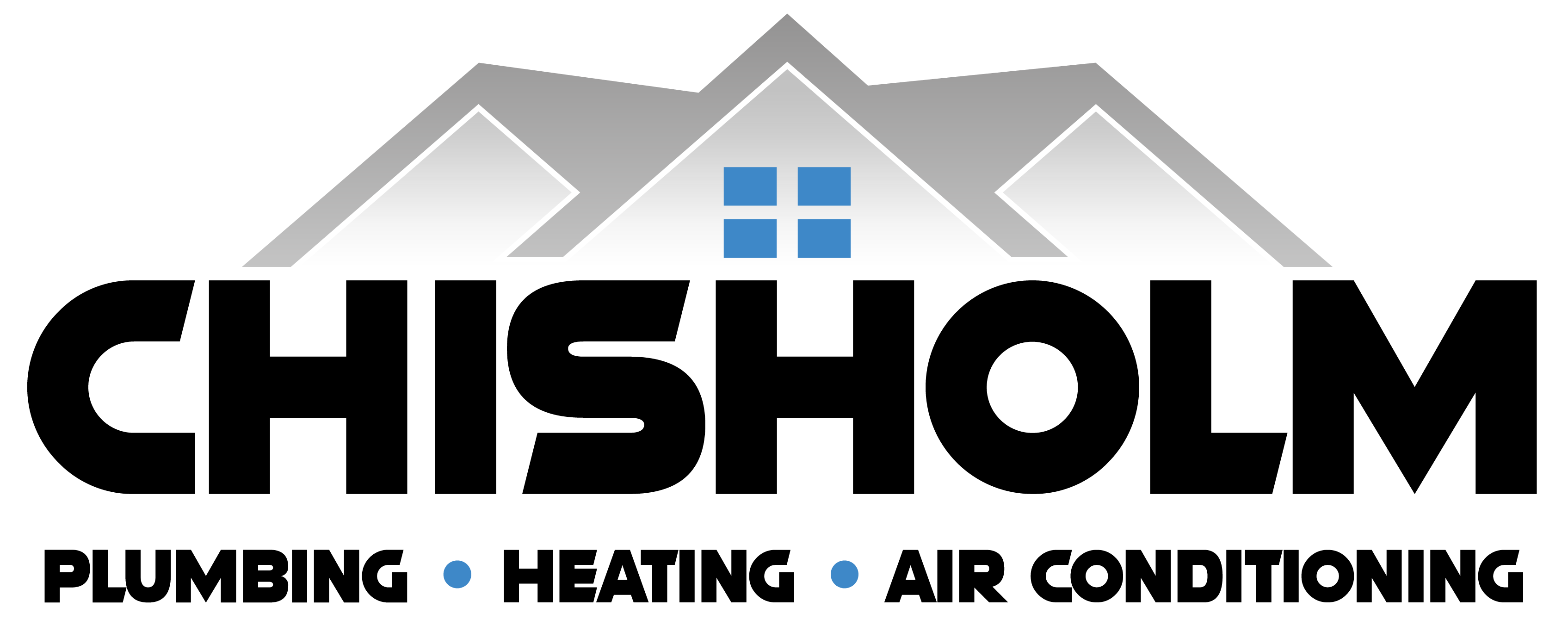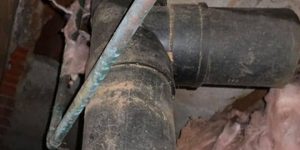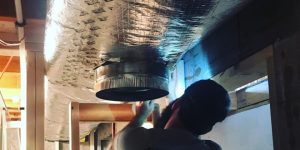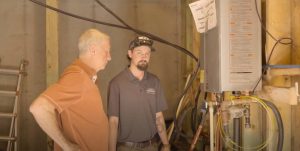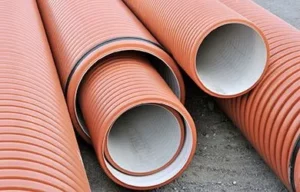
As temperatures drop, maintaining a warm home while keeping energy bills manageable is a priority for many Liberty, SC, homeowners. Improving energy efficiency in winter not only reduces heating costs but also keeps your home comfortable during the coldest months. A few simple adjustments and routine maintenance can make a big difference in retaining warmth and ensuring your heating system doesn’t have to work harder than necessary.
In this guide, we’ll explore practical steps to improve energy efficiency in your home this winter. From scheduling a heating tune-up to sealing drafts and improving insulation, these strategies can help you stay warm and save money.
Explore our heating services here, or contact Chisholm Plumbing Heating & Air Conditioning to discuss your home’s winter heating needs.
Schedule a Heating System Tune-Up
A professional heating system tune-up is one of the most effective ways to improve energy efficiency in your home. Regular maintenance ensures your heating system operates smoothly, reducing the likelihood of breakdowns and helping it run more efficiently. A well-maintained heating system requires less energy to keep your home warm, which can lead to noticeable savings on your winter energy bills.
Benefits of a Heating Tune-Up
- Enhanced Efficiency: Routine maintenance helps your system heat more efficiently by cleaning and optimizing key components, so it doesn’t have to work harder to keep your home warm.
- Reduced Risk of Breakdowns: Technicians inspect parts for wear and tear, identifying potential issues before they lead to unexpected breakdowns, especially during peak winter usage.
- Improved Safety: An inspection also includes checking for gas leaks and ensuring safe operation, which is particularly important for homes with gas furnaces.
To keep your heating system performing at its best, schedule an annual tune-up before winter hits. Our heating maintenance services at Chisholm Plumbing Heating & Air Conditioning include thorough inspections and tune-ups to ensure your system is ready to handle the colder months.
Seal Doors and Windows to Prevent Drafts
Drafts around doors and windows are a common source of heat loss in homes, making your heating system work harder and leading to higher energy bills. By sealing these gaps, you can keep warm air inside, reduce energy waste, and increase your home’s comfort.
DIY Tips for Sealing Drafts
- Weatherstripping for Doors and Windows: Weatherstripping is a simple and affordable solution to prevent drafts around doors and windows. Choose adhesive-backed foam strips or rubber weatherstripping to seal gaps and stop cold air from entering.
- Caulk Window Frames: Use caulk to fill small gaps and cracks around window frames. This creates an airtight seal, keeping the cold out and the warm air in.
- Install Door Sweeps: Door sweeps are effective for blocking drafts that come in from under exterior doors. They’re easy to install and help maintain indoor warmth.
- Window Insulation Kits: Temporary window insulation film adds an extra layer to your windows, helping to reduce heat loss, particularly if you have single-pane windows.
Taking a few hours to seal these areas can make a big difference in your home’s energy efficiency. If you’re looking for further assistance with winterizing your home’s heating system, reach out to Chisholm Plumbing Heating & Air Conditioning.
Upgrade to a Programmable or Smart Thermostat
Upgrading to a programmable or smart thermostat is an easy way to improve your home’s energy efficiency during winter. These thermostats allow you to set a heating schedule that matches your routine, ensuring you’re only using energy when you need it. By lowering the temperature when you’re asleep or away from home, you can reduce heating costs without sacrificing comfort.
Advantages of Programmable and Smart Thermostats
- Customized Temperature Settings: Programmable thermostats let you set different temperatures for different times of the day. For instance, you can automatically lower the temperature at night and raise it just before you wake up.
- Remote Control with Smart Thermostats: Smart thermostats allow you to control your home’s temperature remotely from your phone. They also learn your preferences over time, adjusting automatically for even more efficient heating.
- Energy Savings: A programmable thermostat can save up to 10% on annual heating costs. By using it effectively, you can create a more efficient heating schedule that minimizes waste.
If you’re considering an upgrade, Chisholm Plumbing Heating & Air Conditioning offers thermostat installation and replacement services to help you make the switch to a more energy-efficient setup.

Improve Insulation in Key Areas
Proper insulation is essential for keeping warm air inside your home during winter and reducing the demand on your heating system. Key areas, like the attic, walls, and basement, are particularly important to insulate, as they can account for a significant amount of heat loss. Improving insulation helps maintain a comfortable indoor temperature and lowers your energy bills by reducing the amount of heat needed.
Important Areas to Insulate
- Attic Insulation: Since heat rises, your attic is one of the primary areas where warmth can escape. Adding insulation or increasing the insulation’s R-value (a measure of thermal resistance) can help keep heat in and make your home more energy-efficient.
- Wall Insulation: In older homes, walls may lack proper insulation. Adding insulation to exterior walls can make a big difference, helping to keep the cold out and retain warmth indoors.
- Basement or Crawl Space Insulation: Uninsulated basements or crawl spaces allow cold air to seep up into the main floors. Proper insulation in these areas creates a thermal barrier, keeping warm air where you want it.
Boosting insulation can dramatically improve your home’s winter energy efficiency, especially when combined with other measures like sealing drafts and using an efficient heating system. Contact Chisholm Plumbing Heating & Air Conditioning if you’d like guidance on improving your home’s insulation and winter heating efficiency.
Close Off Unused Rooms and Vents
If you have rooms in your home that aren’t regularly used, closing them off during winter can reduce the workload on your heating system and help conserve energy. By shutting doors to unused rooms and closing vents in those spaces, you can focus your heating system’s efforts on the areas you use the most, improving efficiency and potentially lowering heating costs.
How to Maximize Efficiency by Closing Off Rooms and Vents
- Shut Doors to Unused Rooms: Keeping doors closed in unused rooms helps contain heat in areas where you need it most. This strategy reduces the square footage your heating system has to warm.
- Close Vents in Unused Spaces: By closing vents in rooms that are rarely used, you direct warm air to occupied areas of the home, allowing for faster and more efficient heating.
- Monitor Your Thermostat: Make sure that closing off certain rooms and vents doesn’t cause your heating system to cycle on and off frequently. You may need to adjust the thermostat settings slightly to maintain efficiency.
While closing off unused rooms can be helpful, it’s also important not to overwork your heating system. If you’re unsure about the best ways to optimize your system’s performance, reach out to Chisholm Plumbing Heating & Air Conditioning for expert advice and assistance.
Use Energy-Efficient Window Treatments
Windows are a significant source of heat loss, even if they’re closed tightly. Installing energy-efficient window treatments, such as thermal curtains or insulating blinds, can help prevent warm air from escaping and keep cold air out. These window treatments create an additional barrier against the cold, allowing your heating system to work more efficiently and helping maintain a comfortable indoor temperature.
Types of Energy-Efficient Window Treatments
- Thermal Curtains: Made from thick, insulated materials, thermal curtains are designed to reduce heat loss by up to 25%. Close them at night or during particularly cold days to retain more heat in your home.
- Insulating Blinds: Honeycomb or cellular blinds are designed with pockets that trap air, creating a layer of insulation. They’re highly effective for keeping warmth inside, especially on windows that get little sunlight.
- Weatherproof Window Film: Window insulation film is another option for adding a barrier to single-pane windows. It’s easy to apply and can reduce drafts during the coldest months.
Adding energy-efficient window treatments is a simple and affordable way to boost winter energy efficiency. For more guidance on keeping your home warm and your heating system efficient, visit Chisholm Plumbing Heating & Air Conditioning’s service area to see how we can help in Liberty and surrounding areas.
Consider Ceiling Fans for Heat Circulation
Ceiling fans aren’t just for cooling—they can also help distribute warm air more evenly throughout your home during winter. By reversing the direction of your ceiling fans, you can push warm air that gathers near the ceiling back down into the room. This simple step reduces the workload on your heating system, leading to a more comfortable and energy-efficient home.
How to Use Ceiling Fans for Winter Efficiency
- Switch the Fan to Reverse Mode: Most ceiling fans have a switch to reverse the blade direction. Set the fan to spin clockwise in winter, which will push warm air downward.
- Set the Fan on Low Speed: Running the fan at a low speed prevents drafts while gently circulating the warm air, making the room feel more evenly heated.
- Use Fans in High-Ceiling Rooms: Ceiling fans are especially effective in rooms with high ceilings, where warm air naturally rises. This helps keep the space warm without overworking your heating system.
Using ceiling fans in winter can help you maintain a comfortable temperature and reduce heating costs. For additional energy-saving tips or help with winter heating preparation, contact Chisholm Plumbing Heating & Air Conditioning—we’re here to help!
Conclusion
Improving energy efficiency during the winter doesn’t have to be difficult. By following these tips—scheduling a heating tune-up, sealing drafts, upgrading insulation, and making use of simple tools like thermal curtains and ceiling fans—you can keep your Liberty, SC, home warm and comfortable while reducing energy costs. These adjustments can make a noticeable difference in your energy bills and help extend the life of your heating system.
If you need professional assistance with winter preparations, Chisholm Plumbing Heating & Air Conditioning is here to help. From heating maintenance and repairs to installation and upgrades, our team provides reliable services to keep your home efficient all season long. Contact us today to schedule a service or learn more about our heating solutions for Liberty and surrounding areas.

